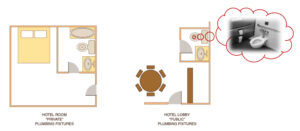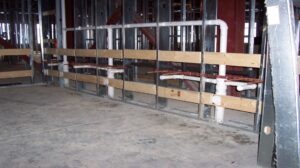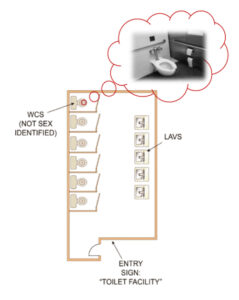
International Plumbing Code: Providing options for designers of modern public restrooms
From its inception, the International Plumbing Code has prioritized privacy for occupants of public restrooms
The International Plumbing Code (IPC) was the first code developed with the full cooperation of the three model code groups: the Building Officials and Code Administrators International, Inc. (BOCA), the International Conference of Building Officials (ICBO), and Southern Building Code Congress International, Inc. (SBCCI). The intent was to regulate plumbing with the most technically accurate code. The original intent of the IPC was to recognize all acceptable methods of construction for various plumbing systems. The code did not attempt to arbitrarily restrict any method, material, concept or system. Since its initial development, the IPC has been updated through its code development process, with participation from widely recognized experts.
Privacy has always been part of the IPC
From its inception, the IPC has prioritized privacy for occupants of public restrooms. In fact, the original 2000 edition of the IPC included a section requiring a separate compartment with walls or partitions and a door for each water closet in a public restroom to ensure privacy. In the 2006 edition, these provisions for privacy were extended, with the addition of a section requiring a separate area with walls or partitions to provide privacy for each urinal in a public restroom. This section also identified the dimensions of the partition.
A code section was introduced in the 2012 edition of the IPC to address concerns about maintaining appropriate behavior inside public restrooms. The doors of multiple-occupant restrooms are prohibited from being locked from the inside of the room. Restricting the egress door in this way reduces the possibility of inappropriate activities that are more likely to occur when an occupant can restrict entry to the room.
Subsequent editions of the codes, up to and including the 2021 IPC and International Building Code (IBC®), continued to offer a toolbox of practical and safe solutions for the design community—here are a few examples.
Clear definitions of public and private restrooms
Codes, by their very nature, are technical documents. Every word, term and punctuation mark can change the meaning of a technical requirement. The definitions of public and private were modified to clarify between “public or public utilization restrooms” and “private restrooms.” This was especially helpful when dealing with the classification of plumbing fixtures. There is now a clear distinction as to which plumbing fixtures are intended to be configured for public use. The definition of “public” has gone from applying to fixtures within a specified list of occupancy types to applying to fixtures in any occupancy type having unrestricted exposure to walk-in traffic. The definition of “private” has undergone a similar change and simply applies to fixtures that are not public.

New fixture calculations for better accessibility
The regulations in Section 403.1.1 of the 2021 IPC, covering fixture calculations, have remained unchanged except for the addition of one important exception. The new Exception 2 offers a different way to design facilities that can be used by all genders. Such multiple-user facilities are available for any person to use, regardless of sex or gender. Where multiple-user facilities are designed in this manner, the minimum fixture count is calculated at 100%, based on the total occupant load of the building.

This requirement overrides the base section requirement for dividing the total occupant load in half (assuming a 50-50 male/female distribution) when applying the fixture ratios of Table 403.1. The calculations are straightforward forward where the male and female fixture ratios in Table 403.1 are identical. However, where different table ratios are indicated, the calculations will require adjustment to accommodate the difference. When using this method, all fixtures required to be accessible must comply with the applicable provisions of standard ICC A117.1 (Accessible and Usable Buildings and Facilities) and each urinal must be in a stall that provides privacy in accordance with Section 405.3.5.
In 2018, code provisions were added to the IPC (Section 403.1.2) and IBC to allow toilet fixtures located in a single-user toilet facility to be counted toward the total number of fixtures required for an occupancy, despite their designation by sex or family. In 2021, Section 403.1.1 Exception 3 was added to clarify how toilet facilities that are configured to allow use by either sex can also be used. Where a building is designed to have single-user toilet facilities, and the male and female fixture ratios in Table 403.1 are identical, the distribution of sexes is not required. However, where different table ratios are indicated, the calculations will require adjustment to accommodate the difference. This is basically saying that the intent of these changes is not to reduce the total quantity of plumbing fixtures required for a building.
Fixtures in single-user toilet rooms count towards total required quantities
Section 403.1.2 was modified in the 2018 edition of the IPC such that the number of plumbing fixtures in all single-user toilet and bathing rooms counts toward the total quantity required for a building. Language was added stating that the required number of plumbing fixtures for a building or space can be located in single-user facilities, separate facilities or a combination thereof. In the 2021 edition of the IPC, the language was modified further.
The text now reads:
403.1.2 Single-user toilet and bathing room fixtures. The plumbing fixtures located in single-user toilet and bathing rooms, including family or assisted-use toilet and bathing rooms that are required by Section 1109.2.1 of the International Building Code, shall contribute toward the total number of required plumbing fixtures for a building or tenant space. Single-user toilet and bathing rooms, and family or assisted-use toilet rooms and bathing rooms shall be identified as being available for use by all persons regardless of their sex.
The total number of fixtures shall be permitted to be based on the required number of separate facilities or based on the aggregate of any combination of single-user or separate facilities.
Given that single-user facilities can serve all persons, the number of plumbing fixtures in those rooms can count towards the total number of fixtures required for a building. In this case, single-user facilities must be identified as being available for use by all persons, regardless of their sex or gender.
Multiple-user non-separated toilet facilities

Toilet facilities designed for multiple users regardless of sex or gender are now possible with the addition of two new exceptions to Section 403.2 covering separate facilities. Exception 5 provides an allowance that single-user toilet rooms not be designated by sex. Exception 6 introduces the new concept of multiple-user toilet facilities designed to serve all sexes and genders, like the new concept introduced in Section 403.1.1.
IPC development process is based on consensus and transparency
The Code Council is committed to building consensus on the changes made to its family of codes (I-Codes). The code development process used to facilitate changes was developed to be open, balanced, transparent and inclusive, with built-in safeguards to ensure that no single group or individual’s interests can dominate or sway any outcomes. Through this process, the IPC and all other I-Codes continue to be the world’s standard for safety and integrity.








